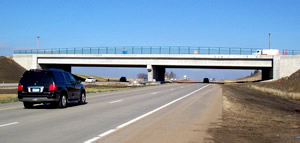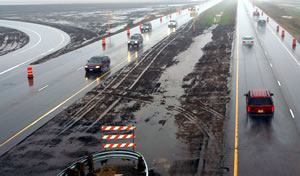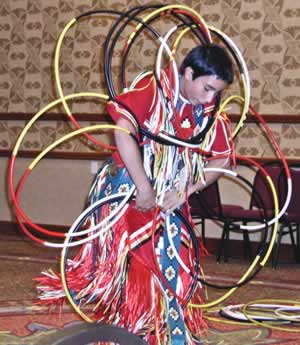 |
 |
|
 |
Mn/DOT completes 75 projects during 2004 season to improve safety, mobility |
 |
 |
 |
|
The recent completion of the Hwy 52-75th Street NW interchange in Rochester marks the first major milestone of the Hwy 52 reconstruction project (ROC 52). Photo by Brian Jergenson
|
Projects ranging from a new Hwy 57 bridge at Wanamingo in Goodhue County to adding lanes on the heavily traveled I-694/I-94 corridor in the northern Twin Cities suburbs wrapped up Mn/DOT’s 2004 construction season, the largest in its history.
The department’s investment for the 2004 construction season in new projects, projects continued and those that were completed topped $1 billion. Mn/DOT completed 75 projects this season.
In addition to new lanes on I-694/I-94 between I-494 in Maple Grove and Hwy 152 in Brooklyn Center, completed projects in the Twin Cities metro area include:
- I-35E Lexington Avenue bridge, reconstruction of the bridge between Hwy 13 and Shepard Road in St. Paul
- Hwy 55/Hwy 62, reconstruction of the highways’ interchange in south Minneapolis
- Hwy 100, reconstruction of the roadway to a four-lane freeway design in Golden Valley, Crystal, Robbinsdale and Brooklyn Center
Major project completions in Greater Minnesota include:
- Reconstruction of a 1.4-mile section of Hwy 53 (Piedmont Avenue) in Duluth between 1-35 and Trinity Road
- Reconstruction of Hwy 23 between Waite Park and Cold Spring to four lanes
- Construction of the new Hwy 10 (Main Avenue) bridge that connects Moorhead and Fargo, N. D.
- Reconstruction of Hwy 371 to four lanes between Fort Ripley to its junction with Business Hwy 371 in Brainerd
 |
A ribbon-cutting event Oct. 28 marked the completion of a new Hwy 52 interchange at Dakota County Road 46 in Coates. Photo by David Gonzalez |
The construction season also marked completion of the Hiawatha light rail line’s first segment and making substantial progress on the department’s first major highway project using the design-build process, Hwy 52 in Rochester (see article below).
Many of the newly completed projects reflect substantial community contributions to their design and appearance.
In Duluth, for example, citizens influenced the renovation of 1.4 miles of Hwy 53. Suggestions from citizens influenced lighting, sidewalks and other aspects of the project’s streetscape, said John Bray, special assistant to the district engineer.
Input from residents of the Fargo-Moorhead metro area resulted in the new bridge’s having a pedestrian plaza at the midway point to invite appreciation of the Red River of the North’s valley and link the two cities’ downtown areas.
A series of public meetings on the Hwy 100 project led to building noise walls, adding landscaping and other esthetic improvements.
Project managers also worked closely with business communities and other leadership groups to minimize the effects of construction on commerce and mobility while the projects were under way.
The light rail line now provides service between downtown Minneapolis and Fort Snelling. Work continues to extend the line to the Minneapolis-St. Paul International Airport and to the Mall of America in Bloomington.
Other continuing projects in the Twin Cities area include rebuilding the Hwy 61/I-494 corridor in the eastern St. Paul suburbs, including the Wakota Bridge in South St. Paul, and adding lanes to I-494 from Hwy 212/5 to Hwy 55.
New and continuing projects in Greater Minnesota include rebuilding Hwy 14 to a four-lane design between Waseca and Janesville, reconstruction of Hwy 23 between Willmar and New London to four lanes and rebuilding 11 miles of Hwy 52 through Rochester.
Funding for the increased level of highway construction activity comes from a special $450 million appropriation from the 2000 Minnesota Legislature, the $900 million bond-accelerated program initiated by the Pawlenty-Molnau Administration and the state’s regular allocation of funds from the Federal Highway Administration.
“I know it’s a not a surprise to anyone who’s traveled throughout Minnesota this summer this year that a great deal of road work was going on,” said Lt. Gov. Carol Molnau.
“The progress we made on Mn/DOT’s construction program this season reflects our commitment to complete more projects, complete them faster and do them better,” Molnau said.
By Craig Wilkins
Interchange completion marks first major milestone of ROC 52 project
A stiff wind and scattered rain failed to dampen spirits Oct. 28 at an event commemorating the completion of the Hwy 52-75th Street NW interchange in Rochester.
The completion of the interchange, which will do much to improve safety along the Hwy 52 corridor, marks the first major milestone of the Hwy 52 reconstruction project (ROC 52). Lt. Gov. Carol Molnau, District 6 Engineer Nelrae Succio and other dignitaries gathered to cut a ribbon for the new interchange.
Between January 1997 and December 2003, 85 crashes occurred at the 75th Street at-grade intersection. Thirty-five of those crashes resulted in injuries and four of the crashes resulted in fatalities.
Molnau highlighted the significance of this major safety improvement, but added that the new ROC 52 interchange is just one part of the overall vision for a new Hwy 52 from Rochester to St. Paul.
“The ultimate goal of this ‘Vision 52’ planning effort is that all of the existing at grade intersections will be replaced with interchanges, bridges and a connecting local road system comparable to our interstate highway system,” Molnau said.
“The 75th Street interchange, and completion of the 65th and 85th Street bridges next year, brings us one step closer to that vision,” she said.
The vision for Hwy 52 became clearer later in the day when Molnau traveled north to Coates to participate in another ribbon-cutting event for a new Hwy 52 interchange at Dakota County Road 46.
Molnau said although ROC 52 is Mn/DOT’s first design-build, best value highway project, it won’t be the last, in part because of the many successes experienced by using that approach in Rochester.
By Brian Jergenson, District 6 public affairs coordinator
|
|
back

|
 |
Conference focuses on transportation, tribes partnerships |
 |
 |
 |
|
Three Winters in a row! Darrell Winters, Tribal Employment Rights Ordinance Director, White Earth Reservation Tribal council; Bob Winter, director, Mn/DOT District Operations Division, and Roger Winter, chair, Becker County Board of Commissioners, White Earth Band of Ojibwe. Photo by John Bray
|
More than 120 people attended the third annual Tribes and Transportation Conference, held Oct. 19-20 at the Prairie’s Edge Casino on the Upper Sioux Reservation near Granite Falls.
The conference was sponsored by the Minnesota Division of the Federal Highway Administration, the Upper Sioux Community and Mn/DOT’s District 8. Representatives from Mn/DOT, the Federal Highway Administration, Bureau of Indian Affairs, several counties and all 11 Minnesota tribes participated, according to Linda Aitken, Mn/DOT tribal liaison.
The theme of this year’s conference was Community and Economic Development through Transportation Partnerships.
As in previous years, much of the conference focused on topics of interest to those who work with transportation issues on or near Indian reservation lands. This year’s subjects included the new Indian Reservation Roads Program rules, Indian Trust Land and Mn/DOT’s Indian employment policy.
Breakout sessions focused on the steps in transportation planning and opportunities to improve coordination between tribal, state and local government.
Equally important, Aitken said, was the opportunity for planners and decision makers to make connections, get to know each other and begin building partnerships.
 |
After a traditional Dakota meal, Seth Cloud from the Sisseton-Wahpeton Oyate Tribe of South Dakota performed a Hoop Dance as part of the evening’s entertainment. The Pte Duta Singers from the Eci Nonpa Woospe Charter School in Morton provided native singing and drumming. Photo by John Bray |
Round table sessions brought representatives from the tribes together with their local Mn/DOT representatives to begin discussions about ways to improve the tribal consultation process used for long-range planning.
“Who you know often makes the difference,” said Dave Danz, planning director for the Bois Forte Band of Chippewa, during a session on transportation planning. Danz gave the example of the recently completed bridge on Hwy 65 bridge over the Little Fork River Bridge in District 1. Although the bridge was a Mn/DOT project, the Bois Forte tribe provided $1.5 million in federal Indian Reservation Road funds to get the project completed sooner because the bridge serves as the gateway to the Nett Lake Reservation.
“It was the personal relationships that we have built that allowed the project to come together,” said Danz. “We knew Mike Robinson (Mn/DOT’s District 1 engineer) on a first name basis, so we could pick up the phone and call him. That relationship, together with relationships we have with the BIA allowed us to work together—and a year and half later we had a bridge.”
Linda Zemotel, program development supervisor in the Office of Investment Management, agrees.
“The most valuable parts of the conference for me were the opportunities to meet each other and to learn more about each other. It is important for us to work together as equal partners, and to do that we need to understand and appreciate our cultural differences,” she said.
For more information about tribes and transportation, check on the online handbook at www.dot.state.mn.us/mntribes/handbook.
By Kay Korsgaard
|
back

|
 |
Agencies offer tips on safely making it through winter |
 |
 |
 |
|
The image above is part of Mn/DOT's new winter safety campaign that will be seen on billboards, posters and other materials around the state. |
Minnesotans may dream of the idyllic Lake Wobegon, but sooner or later, the frigid reality of Frostbite Falls sets in.
That’s where the Minnesota Winter Hazard Awareness Week, scheduled for Nov. 8-12, will come in handy. The purpose of the week is to arm citizens with essential safety tips for work, play, home and travel during the state’s snowy season.
Sponsored by a partnership of public and non-profit groups, including Mn/DOT, the week will feature different topics and tips each day:
Also on Nov. 8, Mn/DOT officially kicks off its annual snow and ice maintenance efforts. This year, more than 100 newly trained snowplow operators will join a veteran force of 1,500 Mn/DOT maintenance workers to keep the state’s roads clear of snow and ice.
Besides Mn/DOT, the Winter Hazard Awareness Week’s sponsors include the Minnesota departments of Education, Health, Natural Resources and Public Safety; American Red Cross; Insurance Federation of Minnesota; Minnesota Safety Council; Minnesota State Fire Chiefs Association, and the National Weather Service.
For more information, visit the Department of Public Safety’s Web site at http://www.hsem.state.mn.us/whaw.asp. To learn about Mn/DOT’s winter safety campaign, contact Kevin Walker, Metro District public affairs coordinator, at 651/582-1362.
|
back

|
 |
Kahnke succeeds retiring Ron Gipp as Audit director |
 |
 |
 |
|
Ron Gipp (at left) and Dan Kahnke (at right) discuss Kahnke’s new role as the Audit director with Suzie Thayer, a principal auditor with Audit. Photo by David Gonzalez |
Dan Kahnke, formerly the external audit manager with the Audit Office, succeeds Ron Gipp as director. Gipp retired Nov. 2 after 34 years of service with Mn/DOT.
Kahnke’s appointment begins Nov. 3. In his new position, he will direct audits of the department’s financial, compliance and performance activities.
Kahnke joined the Audit Section in 1980. A Farmington native, he holds a bachelor of science degree in accounting from Winona State University. Kahnke is also a certified government financial manager.
He may be reached at 651/296-3254 or via GroupWise.
|
back

|
 |
New on Web: Information Technology site undergoes makeover
|
 |
 |
 |
|
The newly redesigned Information Technology Web site has useful tools and information for a spectrum of computer users. |
You don’t have to be a techie to find the Office of Information Technology’s redesigned iHUB site valuable, but if you are an information technology specialist, you’ll discover added benefit.
“The site’s makeover allows our customers quick access to computer technology and applications,” said Ray Sullivan, Information Technology.
That’s because the redesigned site follows the 80/20 rule, where 80 percent of the questions users most likely will ask are answered in the top 20 percent of the navigation bar, Sullivan explained.
Scrolling through the site from top to bottom, some of the links you’ll find are:
- Customer Support, which includes links to desktop support (e.g., timesheet, GroupWise and password help, and file management tips); training aids, including a schedule of monthly “Lunch and Learn” sessions on special topics; and videoconference support.
- Policy & Security, which includes the position statement and guidelines for the appropriate use and electronic message policies, and tips for creating and securing passwords.
For the more technically inclined users, there are links to information and tools for:
- Technician Resources, which includes Network Operations Center services and procedures and tools for application developers.
- IT Asset Management, which includes guidelines for department purchasing and surplus equipment management. The latter includes a link to “IT Freebay,” a nod to eBay, the Internet’s popular forum for selling and buying used goods. The catch is: Freebay is intended to facilitate the transfer of computer equipment within Mn/DOT to minimize department purchases. It is not, however, intended for personal use by employees.
- Program & Project Management, which includes tools for information technology project managers, such as a detailed technical architecture and standards and a project management methodology.
In addition, the site includes links to contracts, service level agreements (between the Office of Information Technology and other Mn/DOT offices) and Mn/DOT IT groups.
You can access the Information Technology Web site at http://ihub.oit/
|
back

|
 |
|
 |



